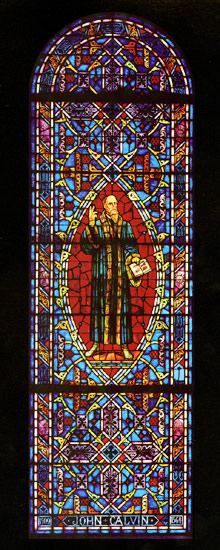
His life was changed in 1532 when, as he said, he was willing “to know the truth.” From that time, he made the Bible his chief textbook and became associated with the Evangelical Party of France.
A friend by the name of Nicholas Cop, a physician in Basel, was elected rector of the University of Paris and for an inaugural address used a speech that had been prepared for him by Calvin. As a result of the address, Calvin and Cop both had to flee to the south of France. While living under an assumed name in order to protect himself from persecution, Calvin began work on the Institutes. In 1536, when Calvin was residing in Basel at the age of 27, he published the work in Latin and became a preacher under the influence of William Fael in Geneva. Because of their efforts to introduce reform, both Calvin and Farel eventually were expelled from the city by the Council of the Two Hundred.
The people of the city of Geneva recalled Calvin, and he returned on Sept. 3, 1541. The reason for his recall was a state of disorder that had arisen in the city, which, at the time, had become a refuge for the persecuted of every land. His lectures attracted thousands of students, and his fame spread.
Calvin was known for his moral courage, selflessness, stern morality, and uncompromising zeal. Under Calvin’s influence, Geneva became known for its religious life.
Although it was approved by the church and Malanchthon, the death of Servetus was was one mark against Calvin’s record. Servetus was burned to death for heresy of anti-Trinitarianism, a crime. Roman Catholics found a source of ridicule in the execution, and many of Calvin’s friends criticized him for it. The execution, however, did not check the growth of anti-Trinitarianism.
Despite his role in Servetus’ death, John Calvin was a refined, conscientious, honest servant of God. His influence as a reformer was outstanding during the era.
The left side border symbols of the Calvin window, numbered from top to bottom are: 1. a graded cross, a Latin-type cross with a base of three steps representing faith, hope, and charity; 2. fleur-de-lis, French for “flower of the lily,” referring to the iris used to represent the purity of the Virgin Mary, as well as the Holy Trinity; and 3. the shield of St. Andrew derived from a legend that said St. Andrew died in Greece on a cross shaped like an X.
The right side border symbols of the Calvin window, numbered from top to bottom are: 1. the “I am” symbol used by Jesus seven times in John’s Gospel is a Greek form of the Hebrew expression “I am that I am,” with the last two Greek words placed in the circle of rays (Exodus 3:14); 2. the Sun of Righteousness, a Messianic symbol for Christ, the monogram within it representing the first three letters (IHS) of the word “Jesus” in Greek, the circle symbolizing the eternity and the rays representing glory; and 3. seven lamps representing the seven gifts of the Holy Spirit which are, traditionally: power, riches, wisdom, strength, honor, glory, and blessing (Revelation 5:12) (cf. John Knox Window, border right 1).














